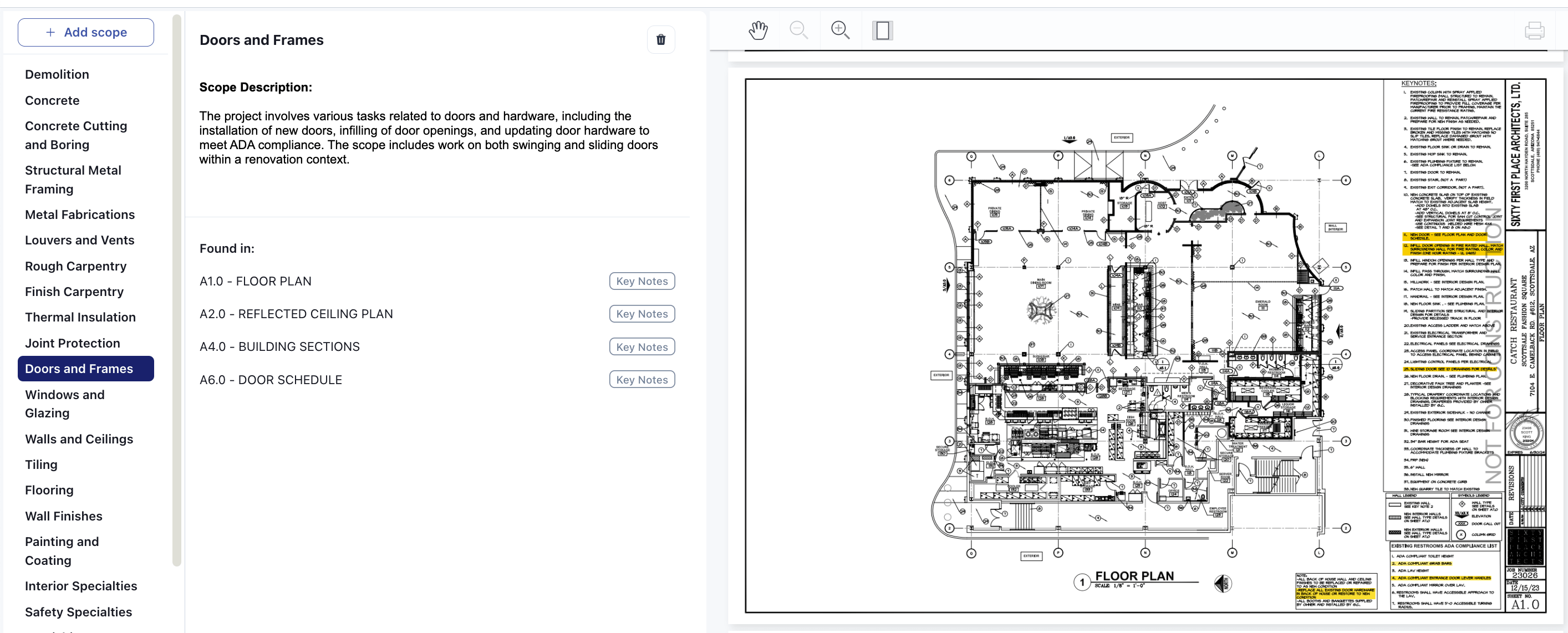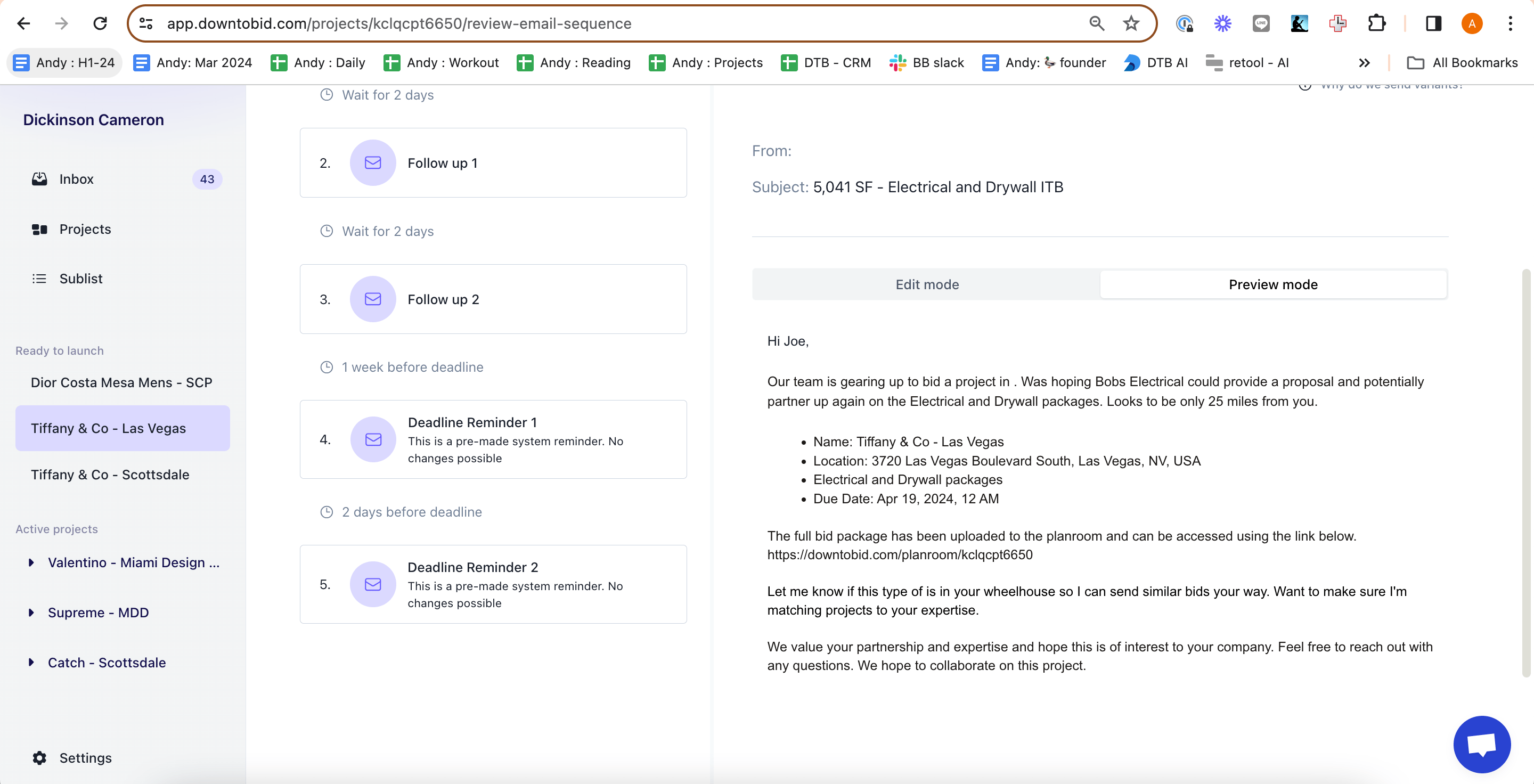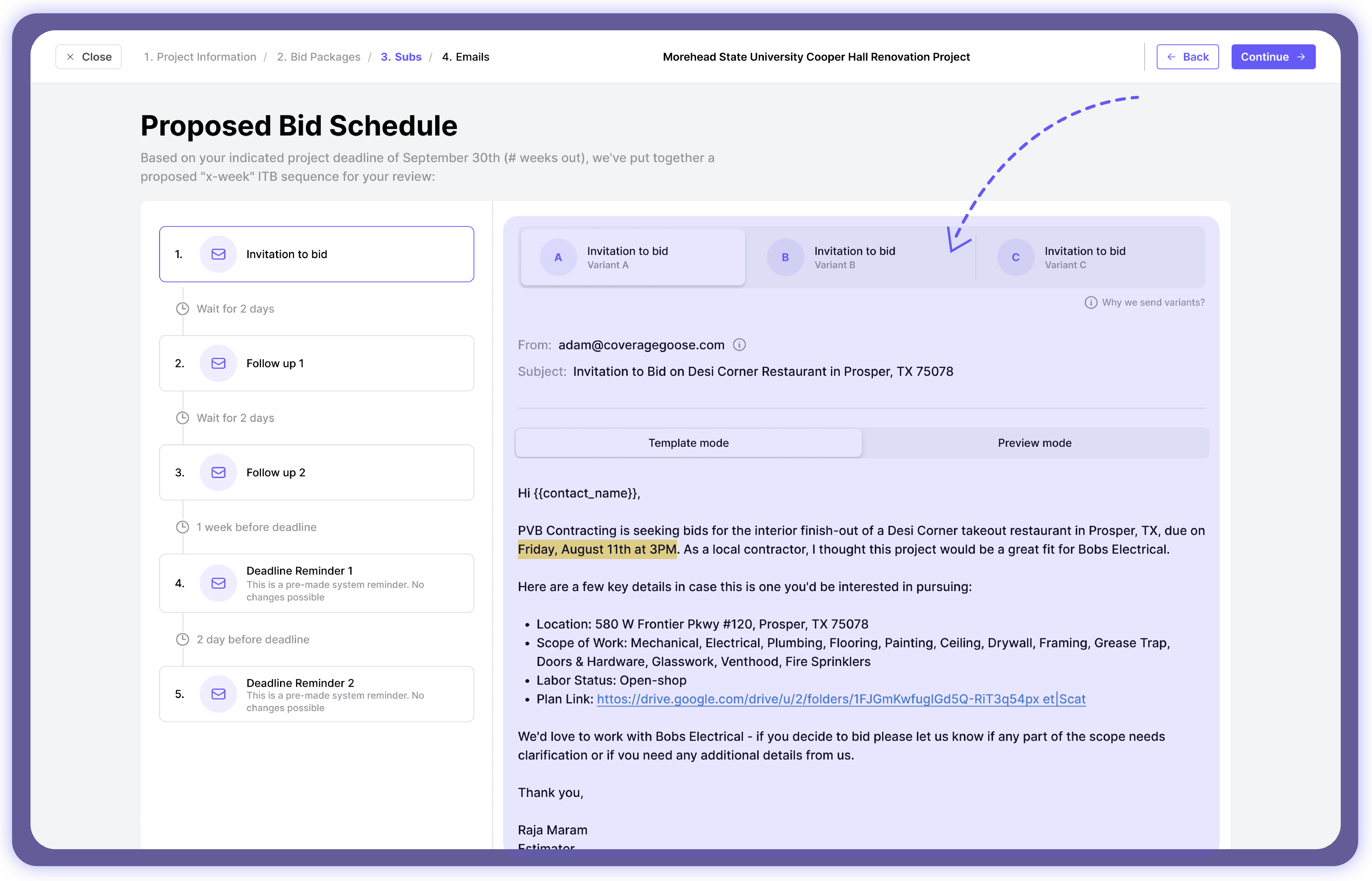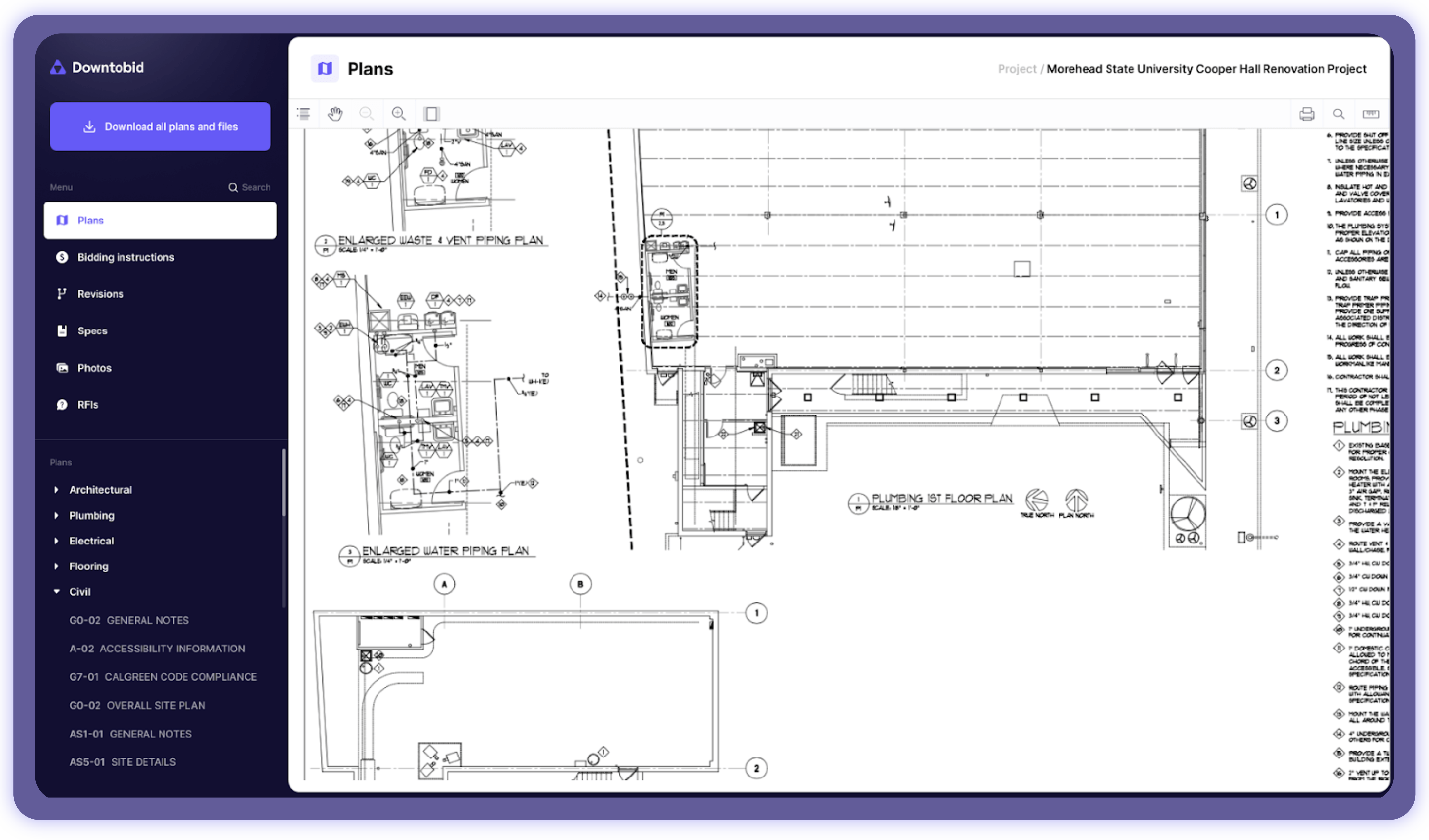Every experienced general contractor knows the headache of putting together a thorough bid package. It's a necessary evil that can easily eat up your time and potentially derail the entire bidding and construction process if you overlook important details.
A customizable construction bid template can help lighten some of your workload. Instead of starting fresh with each new construction project, you can simply fill in your details. In this guide, we'll provide a ready-to-use template designed to help you solicit construction bids that match your project specifications.
Note: This construction bid form provides all the key information you need to create comprehensive bid packages. But if you're looking to streamline the bidding process further, consider using Downtobid. The platform helps by preventing missed scopes with AI checks across major trades and providing quick summaries, suggesting the right bid packages and matching them with qualified local subcontractors, and ensuring ITBs include thorough scope of work sheets You can try out the platform for free.
Bid Packages in a Nutshell
A bid package for construction is a comprehensive set of documents prepared by a construction project owner to inform potential bidders about a project's details and requirements.
Typical items found in a bid package include:
- Construction Designs
- Bill of Quantities and/or Bill of Materials
- Construction Bid Documents
- Specifications
- Scope of Work
- Contract Terms
- Payment Schedule
- Bid Security
These documents serve as the foundation for bidders to prepare and submit their bid proposals. They level the playing field, making sure everyone has the same information. And this standardization benefits both project owners and contractors in several ways:
- Owners can compare and evaluate multiple bids objectively using uniform criteria, ensuring contractor selection is fair and informed.
- Provides necessary details for contractors to mitigate financial risks for both themselves and the project owner.
- Contractors understand the project’s scope, budget, and timeline better, meaning they can create more accurate and competitive bids.
- Helps evaluate project feasibility, identify risks, and make informed decisions about moving forward or reallocating resources.
What's Included in the Bid Package Template? The Three Key Elements
To create a bid package that covers all the bases and gives bidders the full picture of your project, you need to nail down three key things:
- Clear guidelines on how bidders should submit their proposals.
- A detailed scope of work
- An Invitation to Bid
Of course, there's a lot more to a comprehensive bid package, and we've included everything you need in our template (which you can download here), but these three parts will often form the backbone of your packages.
General Guidelines
Include a section with a detailed project overview and instructions for bidders, covering the bid submission and evaluation process. This upfront effort pays off during the bid review process because you’ll get submissions that actually match what you're looking for. Plus, it helps filter out unqualified candidates early on — they don't need to sift through all the pages to know if they can deliver what you need.
Here's what these instructions should cover:
- Bid Preparation Guidelines: The preparation in construction details how bids should be formatted, what to include in the bid proposal template, what documentation is required, and how to submit RFIs.
- Bid Submission Guidelines: Clarify how bids should be submitted, provide deadlines, and outline any procedural requirements.
- Evaluation Criteria: Lay out how the construction bid proposal will be evaluated and what factors will be considered in the comparison process.
- Contract Award Process: Describe the timeline for awarding the contract, methods for notifying the winning bidder, and details on how the contract will be executed.
- Withdrawal or Modification Instructions: If applicable, provide instructions on how bidders can withdraw or modify their bids before the submission deadline.
Any other information to help potential bidders send bids with accurate material and labor costs. You can also follow this commercial bid template.
Scope of Work
The Scope of Work (SOW) is arguably the most important document in any construction bid package. It outlines:
- The work to be done on the project
- How the job should be completed
- Who’s responsible for each crucial task.
Your scope of work needs to spell out the specifics. For instance, specify the type, grade, and dimensions when detailing materials; with labor, outline the skills required and the estimated hours for completion. You want to make sure all team members are kept in the loop and understand the project's short- and long-term goals.
Now, here's the challenge. When you're dealing with medium to large projects, creating multiple SOWs can be a real time sink. You might spend 2-3 hours per project just reading through large construction documents to figure out which bidders you need to get quotes from.
Downtobid makes this process easy for GCs and project managers. Upload a set of plans, and our AI instantly identifies and highlights the required scopes of work directly on the plans.

Instead of sifting through raw blueprints, you can receive an annotated version with all important information clearly called out. From there, you can quickly connect with local, qualified subcontractors from our curated list or subcontractor network. And then you can transition to the next step — inviting subs to bid.
Invitation To Bid
Bid packages often include either an Invitation to Bid (ITB) or a Request for Proposal (RFP).
ITBs are ideal for straightforward construction projects where the client's expectations and project goals are well-defined. On the other hand, RFPs suit unique projects where the client knows what they want but specifics like methods and specifications aren’t fully fleshed out. For this reason, quality and experience weigh heavily alongside pricing in the decision-making process for RFPs.
Since most of your projects already have clearly defined objectives, you'll likely use ITBs. They’re a quick, direct way to award a construction contract, laying out all the necessary details upfront for potential bidders.
It’s worth noting, though, that contractors receive a lot of invitations monthly. It's, therefore, crucial to match each project’s requirements with subcontractors who have the right experience in that scope and complexity level.
It can be tiring creating such invitations from scratch. To save some time, consider using our Invitation to Bid Template or other free construction bid templates. And if you prefer skipping the manual creation of ITBs altogether, you can use our platform to generate personalized ITBs easily.
After identifying scopes of work (as explained earlier), the platform matches these scopes with suitable contractors and drafts personalized ITBS which:
- Provide key project information.
- Target subcontractors uniquely based on their expertise.
- Have attention-grabbing subject lines and simple scope summaries.
- Acknowledge their specific skills and capabilities in the construction industry.

The AI also recommends a schedule for sending out your ITBs, so that you can avoid overwhelming potential subs with needless updates.
And so far the results have been impressive, with users reporting response rates as high as 60%, and receiving numerous bids through our personalized invitations.

To top it off, subcontractors can access a user-friendly plan room to view all construction drawings and plans without needing to log in. This seamless access means they can find and review all crucial project documents with ease.

Simplify Bid Evaluation
Now that your bid packages are prepared and ready, it's time to send them out to qualified subcontractors who are well-suited for the job.
But the job isn't done yet. You’ll want to ensure each subcontractor commits to bidding on the project, and maintain ongoing communication every step of the way.
When updates or changes arise —like addendums to the construction plans— you need to make sure every subcontractor is informed and acknowledges these updates. You’ll also need to be available to answer their questions and provide clarifications on the bid package and project details.
Traditionally, managing this process through bidding platforms can be time-consuming. You often find yourself sending numerous emails, setting up Dropbox links for plans, and writing follow-up emails from scratch.
Downtobid simplifies this process with AI. It automatically prepares email campaigns and follows up with subcontractors who haven’t responded. Your part? Just manage responses in your inbox and wait for the bid proposals to roll in.
It's a simple setup that allows you to dedicate more time to evaluating bids and ensuring they align with what you're looking for. Upload your construction plans for free today.